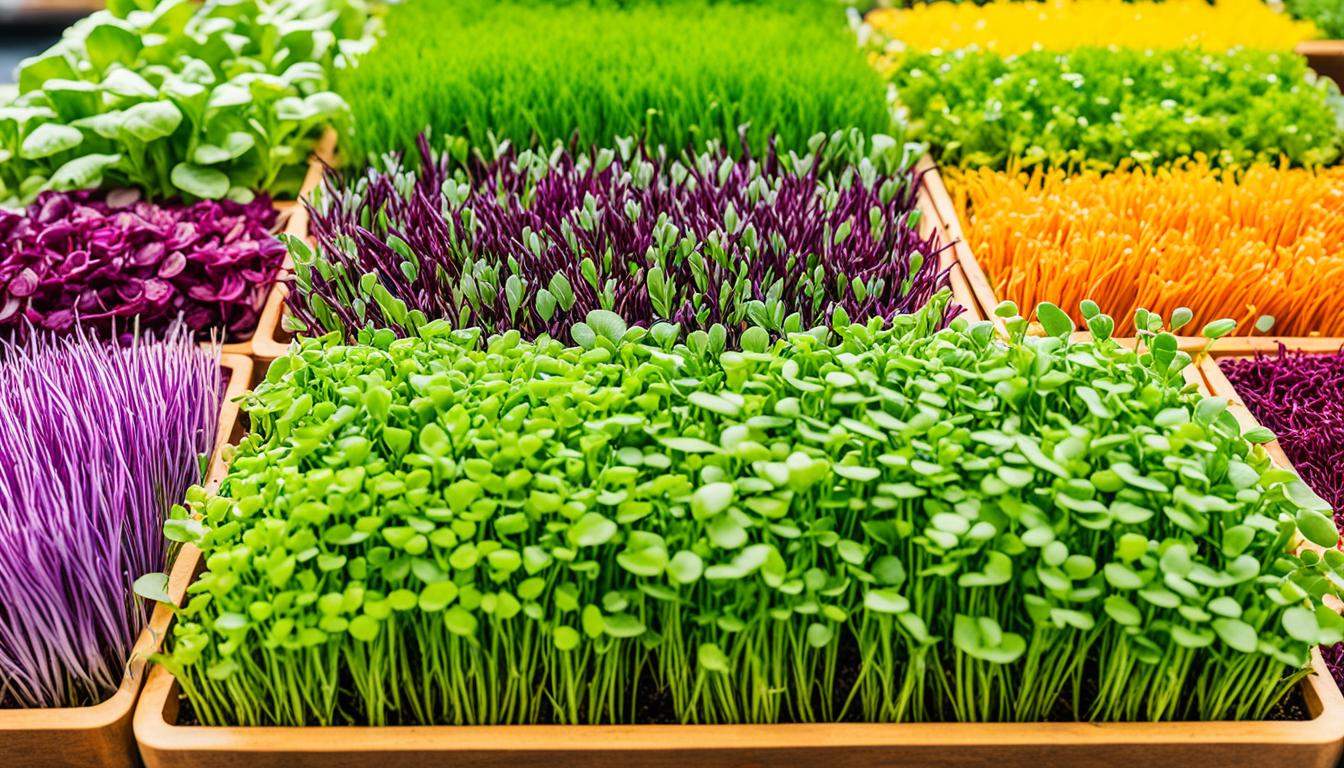As the demand for superfoods continues to surge, the microgreens market is experiencing a boom, capturing the attention of both individual food enthusiasts and commercial entities alike. These tiny but mighty greens are no longer just a garnish; they’ve become a key component in the gastronomic and nutritional repertoires of many. So, when we delve into the question of who buys microgreens, we uncover a dynamic and growing demographic of health-savvy consumers and culinary professionals.
Whether it’s a home cook looking to sprinkle a pop of color and nutrients over their meal or a chef aiming to elevate their dishes with unique flavors and textures, microgreens buyers are diversified. This green market is nurtured by an increasing consumer awareness around the benefits of clean eating and the pursuit of gourmet experiences right from the comfort of one’s kitchen or the tables of avant-garde eateries.
With trends indicating a collective shift towards plant-rich diets and sustainable produce, this fresh produce segment has begun to sprout up everywhere from local farmers’ markets to digital storefronts. Join us as we explore the flourishing landscape of the microgreens niche, a green space where quality, convenience, and nutrition make the most appetizing of trifectas.
Understanding the Microgreens Market
The niche yet expanding landscape of microgreens offers a wealth of opportunities for both growers and sellers. Defined by their intense flavor profiles and nutritional value, these young, tender greens are fast becoming a crucial ingredient in many kitchens. Before we dive into the culinary and health impacts driving this surge, it’s important to grasp the sheer diversity of microgreens purchasers and the unique selling points that differentiate microgreens from other produce.
The Rise of Microgreens in Modern Cuisine
Microgreens have taken the culinary world by storm, transforming from a garnish to a staple in many high-end and experimental dishes. With their vibrant colors, diverse textures, and rich flavors, microgreens add aesthetic appeal and a nutritional punch to meals. This shift is palpable in boutique eateries as well as expansive food service providers, as they all compete to cater to the sophisticated palates of today’s diners. As a result, identifying where to sell microgreens has become easier, with avenues ranging from local gourmet shops to national food distributors seeking these premium greens for their clients.
Health Trend’s Impact on Microgreen Sales
The health food movement has greatly affected consumer preferences and purchasing behaviors, with more individuals opting to buy microgreens online for their personal use. Packed with vitamins, minerals, and antioxidants, microgreens are more than just a food trend; they are a lifestyle choice for those seeking greater health and wellbeing. The ease of online purchasing has further enabled health-conscious consumers to readily incorporate microgreens into their diets, fueling an upward trend in this segment of the market.
As the awareness of microgreens’ health benefits grows, so does their market share. By tapping into this demand, sellers can carve out a niche that not only supports sustainable agriculture but also meets a growing health imperative among today’s shoppers.
Restaurants and Chefs as Primary Purchasers
Within the dynamic market of fresh produce, microgreens buyers near me frequently translates into a bustling community of chefs and restaurants sourcing the finest ingredients for their discerning patrons. The surge in popularity of these miniature greens is largely attributable to the culinary industry’s embrace, with professional kitchens consistently seeking microgreens wholesale options to meet their high-volume needs.
Why do restaurants and chefs vie to incorporate microgreens into their cuisine? The reasons are manifold: the visual appeal of these verdant delicacies enhances plate presentation, their intense flavors augment the taste profiles, and the nutritional density aligns perfectly with current health-forward dining trends. This trifecta of attributes makes microgreens a sought-after commodity in the culinary world.
A critical factor for these primary purchasers—who buys microgreens with a keen eye for quality—is the freshness and quality of the product. Top-tier establishments pride themselves on offering the freshest ingredients, which is why many prefer to engage with local growers they can trust to deliver the very best. Consequently, the relationships fostered between local microgreen farmers and chefs become essential, reflective of a shared commitment to excellence.
For microgreen producers, understanding the nuances of the restaurant industry’s needs is the key to becoming a preferred supplier. Chefs seek microgreens that don’t just appeal to the taste buds but also stand up to rigorous kitchen demands. This necessitates a consistent, reliable supply of microgreens that maintain their texture and flavor from kitchen to table. Those that successfully navigate these requirements find themselves in high demand, particularly in the vibrant circles of urban gastronomy where the question of microgreens buyers near me often leads to lucrative, long-term partnerships.
Who Buys Microgreens: A Breakdown of Consumer Demographics
As the microgreens market continues to burgeon, gaining a deeper understanding of the consumer base becomes essential for microgreens retailers and suppliers alike. A comprehensive demographic analysis not only reveals who is currently purchasing these nutrient-dense greens but also helps in strategizing more effective targeting for potential markets.
Age Groups Showing Interest
The appeal of microgreens spans across various age cohorts. Notably, millennials have shown a pronounced affinity for incorporating microgreens into their diets, predominantly driven by their zeal for culinary experimentation and sustainably-sourced food. Gen Xers and Baby Boomers are also integrating these greens into their meals, primarily due to health consciousness and the nutritional benefits that microgreens offer. A savvy approach for marketers would be to craft messages that resonate with these age-related values and dining preferences.
Income Levels of Microgreen Buyers
Economic factors play a significant role in consumer behavior, and the microgreens niche is no exception. Higher-income groups are inclined towards premium-quality, organic produce, thus making them prime candidates for microgreens consumption. This demographic’s willingness to invest in their health aligns perfectly with the premium nature of microgreens. Conversely, there’s an emerging interest among middle-income brackets as they seek affordable superfoods, suggesting a market opportunity for value-oriented microgreen offerings.
Understanding these demographic nuances aids microgreens suppliers and retailers in refining their marketing strategies, inventory selections, and pricing models. By aligning product offerings with the priorities and capacities of each group, businesses can effectively extend their reach within the sprouting microgreens market.
Online Marketplaces and Digital Sales Trends
The digital age has ushered in a new frontier for microgreens buyers and sellers, with online marketplaces becoming a vital nexus point for transactions. As more consumers look to buy microgreens online, growers have adapted by establishing virtual storefronts across various e-commerce platforms. This shift not only broadens consumer access to fresh, nutrient-dense greens but also allows for agile business models that can respond to rapidly changing market demands.
For those wondering where to sell microgreens, the answer increasingly lies in the digital domain. Online platforms offer tools for microgreen growers to directly engage with their customers, provide detailed product information, and cultivate a loyal following through subscription services and regular updates. Equipped with robust analytics, these digital channels afford sellers invaluable insights into buyer behaviors, preferences, and trends, ensuring they can optimize their offerings in real time.
The ease of online shopping, combined with the growing desire for healthy and locally sourced foods, has significantly contributed to the rise in digital sales of microgreens. Consumers value the transparency and convenience digital purchases provide, alongside the ability to discover new and exotic varieties they may not find at their local grocers or farmers’ markets. Likewise, online marketplaces extend growers’ reach, enabling local producers to enter regional or even national markets.
While e-commerce presents a realm of opportunity, it also requires growers to be more knowledgeable about digital marketing strategies and logistic specifics. A successful online presence is contingent on excellent customer service, reliable shipping, and maintaining the high quality of the microgreens from farm to doorstep. As the trend persists, we can expect to see continued innovation and growth in the ways microgreens buyers and sellers connect in the virtual marketplace.
The Role of Local Farmers’ Markets in Microgreen Sales
Local farmers’ markets play a pivotal role in the microgreens market, fostering a direct connection between microgreens buyers near me and local producers. These vibrant community hubs offer more than just fresh produce; they create an immersive experience where buyers can savor the season’s bounty and discover a myriad of greens that supermarkets often overlook. The intimacy of the farmers’ market setting encourages dialogue, allowing producers to educate consumers on the distinct flavors and nutritional profiles of their microgreens offerings.

Seasonality and Buyers’ Preferences
The allure of seasonal produce cannot be overstated. Fresh, aesthetically-pleasing microgreens capture the attention of those who buy microgreens based on what’s timely and most flavorful. As the seasons change, so do the varieties of microgreens on offer, keeping the selection dynamic and exciting for returning customers. This variability naturally aligns with consumers’ preferences, motivating them to visit farmers’ markets regularly to see what new microgreens are available for their seasonal dishes.
Building Relationships with Local Consumers
Perhaps the most significant advantage for growers selling microgreens at local farmers’ markets is the opportunity to forge lasting relationships with their clientele. These interactions lay the groundwork for a loyal customer base—essential for stability in the fluctuating microgreens market. When growers become familiar faces, they are not just selling a product; they are nurturing a community grounded in the appreciation of high-quality, locally-grown microgreens. The buyers benefit, too, gaining trust in the green goodness they bring into their kitchens, knowing exactly who buys microgreens: chefs, home cooks, and health enthusiasts who all value the transparent and personal buying experience that farmers’ markets uniquely provide.
Microgreens Wholesale: Bulk Purchases and Their Buyers
The landscape of the microgreens market is evolving as microgreens wholesale buyers play an increasingly significant role. These buyers, which include venues like restaurants, hotels, and various institutions, recognize the value of purchasing microgreens in bulk not only for their diverse application in the culinary arts but also for their cost-efficiency and reduced environmental impact due to consolidated shipping.
Microgreens suppliers face unique challenges and opportunities when dealing with wholesale orders. One of the key factors is consistency in quality and supply. Wholesale buyers expect a steady stream of product that meets their rigorous standards, as even minor variations can have a notable impact on their menu offerings or foodservice operations.
Another important aspect for growers is understanding the specific needs of microgreens buyers at the wholesale level. This might include customized packaging to maintain freshness during longer transport, as well as stringent adherence to food safety protocols. To thrive in the wholesale space, growers must build robust relationships with their clients and possess a deep understanding of their business models, which often demand larger volumes and price adjustments that reflect the economies of scale.
Ultimately, succeeding in the microgreens wholesale market hinges on the ability of growers to align their practices with the expectations of wholesale clients, fostering long-term partnerships that benefit all parties involved in the ever-growing microgreens industry.
Specialty Stores and Health Food Retailers
Within the microgreens market, specialty stores and health food retailers emerge as pivotal players, serving the growing demographic who buys microgreens. These shops bridge the gap between microgreen growers and consumers by offering a curated selection of these nutritious greens. Typically situated in communities with a pronounced focus on health and well-being, these establishments are perfectly positioned to respond to the needs of health-conscious shoppers. As high-value nutritional powerhouses, microgreens align well with the ethos of these retailers, who prioritize quality and health benefits in their product offerings.
Microgreens retailers are more than just sales points; they are ambassadors of a healthy lifestyle, providing education and inspiration to their customers about incorporating microgreens into their diets. For those seeking to integrate wellness-oriented foods into their meals, health food stores offer convenient access to a variety of microgreens. This accessibility is key in expanding the customer base, encompassing everyone from gourmet food enthusiasts to individuals dedicated to nutritious eating habits.
Garden-fresh, organic, and bursting with flavor, microgreens are a mainstay in the inventory of these establishments. Moreover, with a deeper understanding of their customer base, specialty retailers have the ability to tailor their selection to meet specific dietary preferences and nutritional requirements, thereby fostering a loyal clientele that appreciates the nuanced inventory curated by these specialized establishments.
Integrating with community-oriented health food stores can be a strategic move for microgreen growers looking to enhance their presence in the market. By fostering strong partnerships, growers ensure consistent visibility among consumers who prioritize the very values that microgreens champion: nutrition, flavor, and freshness.
Microgreens Suppliers and Distributors
The backbone of the burgeoning microgreens market is an intricate network of microgreens suppliers and distributors who ensure that these delicate leafy products reach consumers in their freshest form. Playing a crucial role in the supply chain, these entities work tirelessly to navigate the logistical challenges of keeping microgreens vibrant and market-ready. With the expanding demand from both retail and foodservice industries, suppliers and wholesalers are increasingly adopting innovative preservation and transportation methods.
For microgreens wholesalers, the key to success is balancing scale with quality. Larger quantities must be moved efficiently without compromising the product’s integrity – a task that requires precision and knowledge of perishable goods logistics. By establishing robust systems for temperature control, handling, and speed-to-market, wholesalers can preserve the quality that end-users expect.
Moreover, it’s not just about the logistics. A strong relationship between growers, suppliers, and distributors acts as a driving force behind the microgreens market. These partnerships facilitate a constant flow of information, leading to improvements in cultivation techniques and a better understanding of market trends. Establishing exclusive agreements can also help distributors ensure a steady supply of quality products, thereby bolstering the overall health of the microgreens niche.
Ultimately, the strategic collaboration between microgreens suppliers and distributors is what propels this green wave forward. By guaranteeing quality and seamless delivery, they help microgreens maintain their position as a sought-after commodity in the healthful eating space, satisfying the palate of the modern, health-conscious consumer.
Catering to the Needs of Health-Conscious Individuals
In today’s health-centric society, a distinct segment of health-conscious consumers is emerging as prominent microgreens purchasers. These individuals prioritize nutrition and are always on the lookout for ways to incorporate wholesome, vitamin-rich foods into their diet. Catering to their needs can provide a lucrative opportunity for those who sell microgreens online as well as through traditional outlets.
With the demand for nutrient-dense, convenient, and organically sourced food on the rise, microgreens stand out as an excellent choice for health-aware buyers. Retailers and growers tapping into this market can enhance their visibility significantly by highlighting the health advantages of these tiny yet powerful greens.
Marketing strategies that resonate well with this audience include informative content that underscores the versatility of microgreens. Such approaches not only answer the question “who buys microgreens?” but also create compelling narratives about how easily these greens can be infused into daily meals. Recipes for smoothies, salads, and garnishes, for instance, can exhibit the practical and beneficial use of microgreens among health-conscious households.
To successfully buy microgreens online, consumers seek platforms that offer quality, convenience, and information. Retailers enhancing their online presence with these features can foster loyalty among customers who value not just the product they’re purchasing, but the lifestyle it represents. By aligning with the values and health goals of their clients, sellers can carve out a strong niche in the expansive world of e-commerce for health foods.
Meal Kit and Subscription Box Services Joining the Market
In the dynamic landscape of the microgreens market, the recent surge in popularity of meal kit and subscription box services represents a transformative trend for growers and sellers alike. As consumers seek convenience without compromising on quality and nutrition, these services are increasingly providing an impactful channel for microgreens buyers. Through carefully curated offerings, these companies are packaging the freshness of farm-to-table experiences right at customers’ doorsteps, thereby expanding where to sell microgreens beyond traditional outlets.
For microgreen growers, this new distribution avenue comes with its own set of unique opportunities and considerations. The subscription model, in particular, offers a steady demand and predictable revenue stream, a welcome advantage for planning crop cycles and managing inventory. However, the challenges can be just as real – maintaining the Level of freshness these delicate greens demand during transit is crucial, as is distinguishing their products in a competitive market laden with numerous food and wellness options.
Adapting to these innovative channels demands that microgreen growers and suppliers fine-tune their operations to align with the expectations of meal kit and subscription box companies. This might include investing in robust packaging solutions, forming strategic partnerships, and emphasizing the exceptional nutritional profile of microgreens in marketing efforts. By addressing these elements, growers can effectively tap into this burgeoning sector, ensuring that their greens are not merely a healthful addition but an indispensable component of modern meal planning and consumption.


